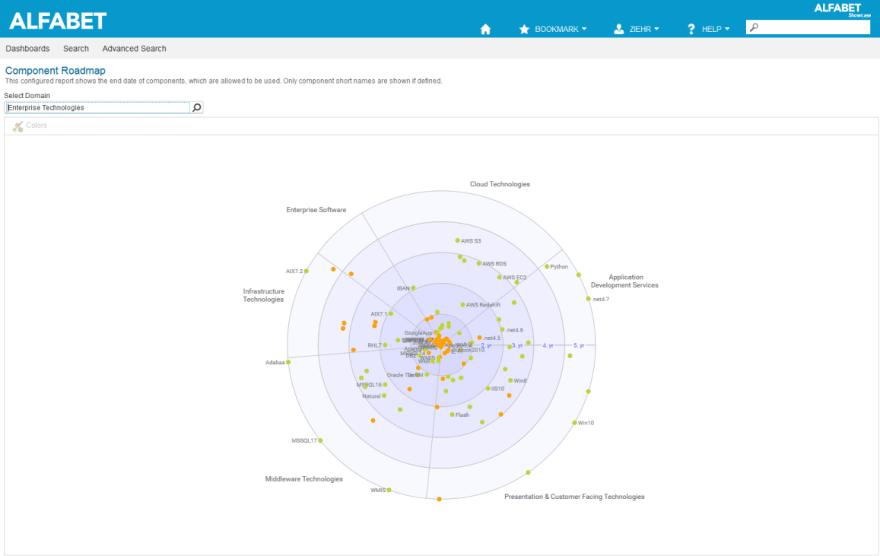Technology requirements for effective IT road mapping
This is part 3 of 5-part our series on road mapping in enterprise architecture, IT planning and portfolio management.
IT road mapping is no small task. It involves an immense amount of planning objects and the knowledge of their dependencies to other objects, their life cycles and their role in the IT plan. This is made exponentially more complicated if you want to maintain various planning scenarios. To do IT planning at this level requires tools with specific abilities. These abilities are listed below.
Ability to interconnect related roadmaps
This ability is required to synchronize the plans of various enterprise architecture (EA) elements to avoid conflicts, delays, and overrun costs and is best done by generating the roadmap from lifecycle information or portfolio information. To interrelate roadmaps, you need to have a powerful centralized repository and functionality for:
- time-tagging of all relevant objects and their lifecycle phases
- monitoring and maintaining vendor technology lifecycles
- status management of elements from planning to development to operational
- tracking of dependencies between EA planning elements that contribute to the roadmap.
Ability to ensure optimal data quality
Strategic IT planning is about making decisions. For decisions to be defendable, it is critical that the data which decisions are based on is consistent and up to date. This challenge can be met by clear distribution of ownership and responsibility for planning objects. Object owners are responsible for the integrity of the information on their objects, and these objects can change frequently. But a tool can ease the burden of maintaining data by making information management user-friendly with features such as wizards for standardized and prompted input and automated workflows for standardizing data maintenance procedures from one instance to another.
Changes to information need to be monitored to ensure integrity and accuracy. Owners need to be alerted when a change may be required due to a roadmap decision in another part of the organization. A comprehensive integrated planning tool with adequate automation can ensure this happens in real-time. Much of the work in keeping data (and the roadmap) current is related to binding decision-making to the updating of information.
Stage gate processes should be established, and as you define them, you should make sure that certain information elements are available and aligned with certain stage gates. The person responsible for an information element signs off on the integrity at that particular stage gate. The information update is thus a positive side-effect of making a decision.
A further requirement for data quality is the ability to integrate with other systems of record such as a business process management system or a configuration management database (CMDB). For the process of IT planning to be effective, it must be integrative, holding information on and defining and maintaining relations between all the relevant planning elements: demands, project proposals, architectural designs, hardware, software, workflows, human resources, corporate policies, business strategies and cost information.
Figure 2: Effective road mapping for IT planning requires tight integration with other IT management disciplines to ensure high data quality.
Any system supporting the IT planning process must be well integrated with the planning system for roadmaps to be accurate.
Ability to make roadmap maintenance a by-product of daily planning tasks
Roadmap maintenance should not be an individual exercise by one particular person in a deliberate act of creation and editing. IT road mapping isn’t a process unto itself but rather the result of a specific process inherent to IT planning. For roadmap management to be effective and efficient, it needs to be embedded in established processes such as a request for new technology, project approval, procurement, strategy operationalization or demand management. In these processes (as in the roadmap), ownership and responsibility need to be clear. Role descriptions and processes should be established functionally as well as geographically. Ultimately, the organization will want to strive for the automation of these day-to-day processes. Automated workflows can make roadmap creation, maintenance and communication easier, more reliable and targeted in a complex environment.
Ability to address the various consumers of roadmaps
The reader will have noticed that this is a constantly recurring message in road mapping. Because IT planning is a highly collaborative discipline involving stakeholders as diverse as business analysts, application owners, enterprise architects, risk managers, IT financial managers, project managers, CIOs and operations managers, roadmaps need to be able to firstly reflect the interests of the various stakeholder groups and secondly provide a platform for stakeholders to collaborate. This means the planning tool needs to:
- encompass all the planning elements relevant to these stakeholders
- be configurable enough to embrace the specific naming conventions of the company
- offer collaboration features such as discussion groups, messaging and notifications
- provide the information in a visualization that is relevant to the user.
Figure 3: This circular roadmap for technology portfolio managers and solution architects shows technologies positioned on a time-axis according to their end-of-life dates. The colors indicate whether they are free for use (green) or need approval (orange). The graph is sectioned according to technology category.
Stay tuned for our next episode on best practice examples of IT road mapping.






Top comments (0)